the history of yeovil's pubs
PUBS HOME PAGE |
PUBS INTRODUCTION |
PUBS BY NAME |
BEERHOUSES |
half moon inn
Silver Street
The Half Moon Inn in Silver Street (shown as 'A' on the map below) was open from at least 1709, when it was mentioned in a Deed of Property, until the 1970's. It was presumably named as such to distinguish it from the Full Moon just across the Borough in Wine Street.
It was a three-storey, double fronted building under a tiled roof. It had a huge sign, depicting a crescent moon, supported by a frame projecting well out into the street as seen in the photographs below and as described by Pevsner in "The Buildings of England - South and West Somerset" as "a nice wrought-iron inn-sign bracket".
The Ministry of Town & Country Planning's Provisional List of Buildings of Architectural or Historic Interest of July 1948 described the building and its neighbours thus - "Silver Street bounds churchyard on east side. Houses on one side only, facing church. The houses themselves are mostly 18th or early 19th century in date. They are not of great merit individually but they retain their Georgian scale and form part of the pleasant surroundings of St John's church. They are therefore of value in a largely modern town. Grade III - 'Half Moon' Public House - Two-storey, three-window brick front. Three-light sash windows to ground and first floors. Key stones. Plain door reveal. Large and elaborate wrought-iron bracket to Inn Sign."
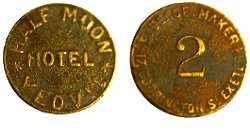 At
left is an
undated, but
probably late
Victorian,
public house
'check' or trade
token issued at
the Half Moon
Inn. It is made
of brass, is
18.7mm in
diameter and has
a plain edge. On
the obverse it
says "HALF MOON
- HOTEL -
YEOVIL" and on
the reverse the
name of the
maker "E SEAGE.
MAKER - 17
CODRINGTON ST.
EXETER" and is
its value - 2D.
At this time two
old pence could
buy you a pint
or two of ale.
Checks were
frequently used
in games, such
as skittles or
quoits where,
for instance,
players would
'chip in' a
check to the
'kitty' which
would be won by
the winning team
to redeem at the
bar. By issuing
checks a
landlord could
guarantee they
would be spent
in his
establishment
only.
At
left is an
undated, but
probably late
Victorian,
public house
'check' or trade
token issued at
the Half Moon
Inn. It is made
of brass, is
18.7mm in
diameter and has
a plain edge. On
the obverse it
says "HALF MOON
- HOTEL -
YEOVIL" and on
the reverse the
name of the
maker "E SEAGE.
MAKER - 17
CODRINGTON ST.
EXETER" and is
its value - 2D.
At this time two
old pence could
buy you a pint
or two of ale.
Checks were
frequently used
in games, such
as skittles or
quoits where,
for instance,
players would
'chip in' a
check to the
'kitty' which
would be won by
the winning team
to redeem at the
bar. By issuing
checks a
landlord could
guarantee they
would be spent
in his
establishment
only.
An indenture dated 24 June 1790 conveyed the Half Moon Inn in Corn Market (today's Silver Street) for £300 by William Latton to Mrs Betty Kitson. In a further indenture, dated 21 March 1798, Betty conveyed the Half Moon to Robert Tucker for £315.
In 1875, 1878,
1879, 1880 and
1882 the Post
Office Directory
noted that Mr
Musgrove ran a
carrier service
to South
Petherton from
the Half Moon
every Monday,
Wednesday and
Friday.
It is
interesting to
note on the 1908
advertisement
for the Half
Moon below that
Nicholson's
London Gin was
being sold for
twelve shillings
(60p) a gallon!
Vincent's factory, making cardboard boxes for the glove trade, existed for many years at the back of the Half Moon. It was reached via the alleyway in Middle Street between the HSBC bank and Ryman's stationers.
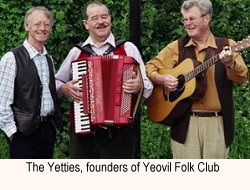 Prior
to
turning
professional,
the
Yetties
set up
the
Yeovil
Folk
Club
in 1963,
initially
at the
Mermaid
Hotel
but
later
moving
to the
Half
Moon. They
booked
people
from all
over the
place,
including
Julie
Felix. Paul
Simon sang
there in
1965, on
an early
pre-Garfunkel
tour.
“We gave
him ten
quid
because
he was
so good”
remembers
Bonny
Sartin
of the
Yetties.
Prior
to
turning
professional,
the
Yetties
set up
the
Yeovil
Folk
Club
in 1963,
initially
at the
Mermaid
Hotel
but
later
moving
to the
Half
Moon. They
booked
people
from all
over the
place,
including
Julie
Felix. Paul
Simon sang
there in
1965, on
an early
pre-Garfunkel
tour.
“We gave
him ten
quid
because
he was
so good”
remembers
Bonny
Sartin
of the
Yetties.
|
Yeovilians remember... Thanks to Mike Bolton for the following - "Buff Biggin was a much loved and admired local cricketer and after he left the Half Moon he ran the pub at Trent. The Half Moon was the home of Yeovil Folk Club in the early 60s run by the Yetties in an upstairs room. I believe that Paul Simon once sang there on an early pre-Garfunkel tour. The pub was then run by Johnny Fisk the landlord." And to Will Rich for the following "Had my first snog at the Half Moon folk club and I don't know about Paul Simon but Julie Felix definitely appeared there. In 1968 a riot started after youths had been drinking heavily there and were encouraged by a couple of French lads to reenact the Paris disturbances of May that year. Several were arrested (including the French boys and yours truly) and the police station was besieged by stone-throwing youths." Thanks to Brian Butt for the following anecdote - "Playing on the skittle alley at the Half Moon was ‘different’. It was upstairs and the slope was such that if you missed the pins on the way up you had a fair chance of getting them as the ball ran back." |
![]()
William Bengefield is noted as licensee of the Half Moon in Pigot's Directories of both 1822 and 1824 and the Poll Book records him there in 1827. However he is in the 1832 Poll Book by virtue of being the occupier of lands at Sun House Farm although it is unlikely that he was connected to the Sun House Inn.
The first licensee on whom there is any detail in the records was Benjamin Thomas. He was noted as early as 1830 in the Land Tax Returns and in several trade directories until 1852. He was born in Stockland, Devon around 1800 and the 1841 census shows him as an inn keeper with his wife Elizabeth, known as Betty or Betsy, 2-year old nephew Francis, three servants and several lodgers. The situation was almost identical in 1851. By the time of the 1861 census Benjamin had left the licensed trade and set himself up as a corn merchant in Middle Street. Betty died in March 1863 and in the 1871 census Benjamin, listed as a corn factor, was still living in Middle Street with his nephew Francis. Benjamin died in March 1872.
The next licensee, Henry Trott, was born around 1823 and both he and his wife, Sarah, were from Stocklinch, Devon where, in 1851 he was recorded as a farmer of 100 acres. He and Sarah were living with his father, James Trott, a retired farmer, and Sarah his mother. By 1861 Henry was licensee of the Half Moon and in 1866 he was advertising himself in Kelly's Directory as licensee of the King's Arms, just along the road. However by 1871 Henry and Sarah had moved back to Yarcombe where Henry worked as a builder.
 John Knight was
born around 1834
in Meltham,
Yorkshire, the
son of
agricultural
labourer and ale
& beer seller
John Knight and
his wife, Nancy.
In 1851 John
junior was also
an agricultural
labourer. During
the next ten
years John
married and he
and his wife,
Sarah, from
Staffordshire,
moved to Yeovil
where John
worked as a
railway engine
driver. The 1861
census lists
them living in
Ebenezer Row in
lower Middle
Street (roughly
where Poundland
is today). By
the time of the
1871 census John
and Sarah, now
with a young son
and daughter,
were living at
the Half Moon
with a couple of
domestic
servants, an
ostler and four
lodgers. John's
occupation was
listed as inn
keeper. He was
still listed as
the licensee in
1875. However
the call of the
steam and grime
of the railways
was obviously
too strong
because by 1881
the family had
moved to the hub
of the railway
world, Swindon,
where John was
again living
every young
boy's dream by
being a railway
engine driver
once more.
John Knight was
born around 1834
in Meltham,
Yorkshire, the
son of
agricultural
labourer and ale
& beer seller
John Knight and
his wife, Nancy.
In 1851 John
junior was also
an agricultural
labourer. During
the next ten
years John
married and he
and his wife,
Sarah, from
Staffordshire,
moved to Yeovil
where John
worked as a
railway engine
driver. The 1861
census lists
them living in
Ebenezer Row in
lower Middle
Street (roughly
where Poundland
is today). By
the time of the
1871 census John
and Sarah, now
with a young son
and daughter,
were living at
the Half Moon
with a couple of
domestic
servants, an
ostler and four
lodgers. John's
occupation was
listed as inn
keeper. He was
still listed as
the licensee in
1875. However
the call of the
steam and grime
of the railways
was obviously
too strong
because by 1881
the family had
moved to the hub
of the railway
world, Swindon,
where John was
again living
every young
boy's dream by
being a railway
engine driver
once more.
Hugh Marsh was born around 1838, son of George and Susannah Marsh, but the family moved to Yeovil quite early in Hugh's life and by 1851 they were living in Paradise Row, Huish. His father was an ostler and even at the age of 14 Hugh was listed as a harness maker. By 1861 Hugh's mother had died but the family were still living at Paradise; Hugh was listed as a saddler while his father had become a brewer. By the time of the next census in 1871, Hugh's father had died. Hugh was now aged 33 and was still living in Paradise Row as a saddle and harness maker with his 19-year old sister, Mary, as housekeeper. However, within the next five years, after more than twenty years of making saddles and harnesses, Hugh was licensee of the King's Arms and was listed in Kelly's Directory. By 1881 he was licensee of the Half Moon, a few doors along Silver Street. By this time Hugh had married Jane Dunn and her daughter, Bessie, worked as a barmaid in the Half Moon. There was also in residence a general servant, a boots and a lodger. By the time of the 1891 census Hugh was listed as a retired publican and was living with Jane in Market Street just around the corner.
The next licensee, Robert Leach, was born in Yeovil in June 1847 the son of pastry cook Henry Leach and his wife, Louisa. In 1851 the family lived in Belmont, next door to the Britannia Inn. He married Ellen in 1873 but he turned out to be one of those roving publicans who seems to move from pub to pub - he was licensee of the George Inn in Middle Street in 1878, licensee of the Pall Tavern with his wife, Ellen, in 1881 and licensee of the Half Moon by 1889. Ellen died in December 1892 and Robert married his second wife, Sarah, during the mid 1890's. However Robert died in the spring of 1897 and Sarah became licensee of the Half Moon where she was to remain until her death, at the age of 64, twenty five years later in the winter of 1922.
Edward Biggin
followed
straight after
Sarah and was
landlord for
more that a
quarter of a
century. His
wife, only
recorded as Mrs
A Biggin, took
over the license
for a couple of
years followed
by their son, BP
Biggin, known as
Buff, until the
1960’s – a
family total of
over forty
years.
map

gallery
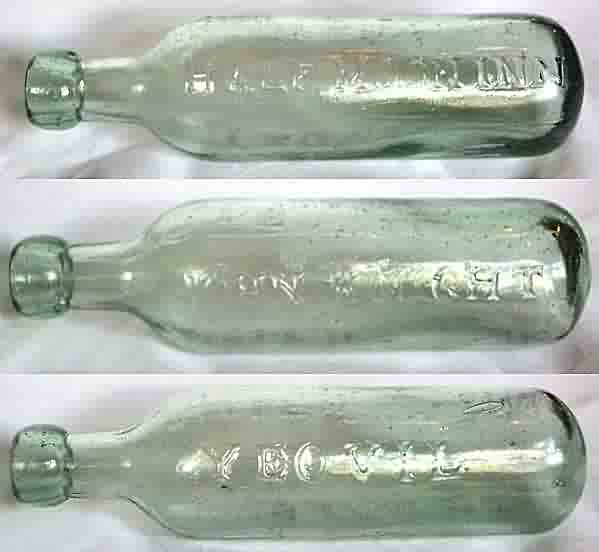
Courtesy of Tony
Rendell
Three images of the same bottle marked "Half Moon Inn", "John Knight" and "Yeovil". John Knight was landlord of the Half Moon Inn, Silver Street, from at least 1871 until around 1875.
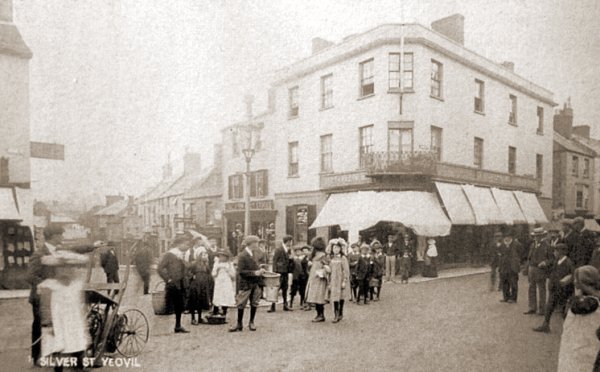
This photograph was taken around 1900 from the Borough, looking towards the junction of Silver Street at left and Middle Street at right. The large building on the corner was London House which was built in the 1830s and occupied mostly by a succession of drapers. It was demolished and replaced with the current bank building, Going down Silver Street was Singleton's boot stores, a greengrocer and then the Half Moon Hotel - seen better in the close-up below,
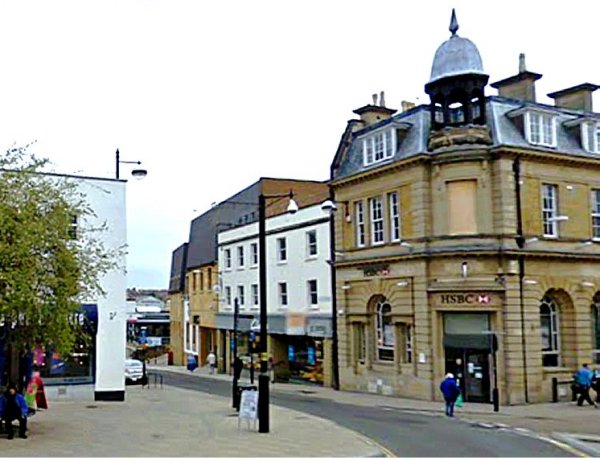
The same scene in 2012 looks completely different.
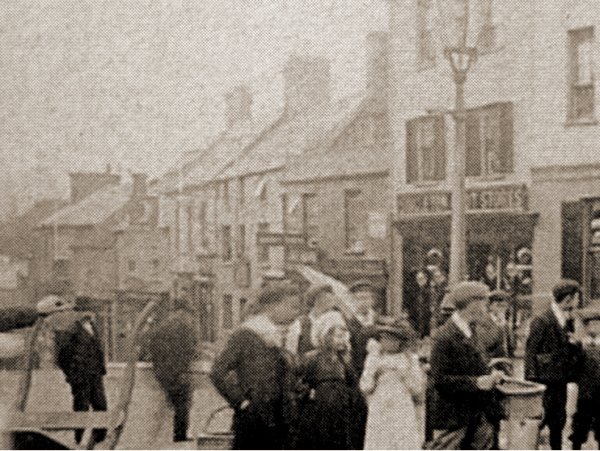
In this enlargement of the central section of the 1900 photograph above, the Half Moon is the three-storey building just to left of centre. If you look carefully you can just make out the large iron framework projecting from the front of the building to support the inn's square sign, depicting a crescent moon, that hangs way out over the street.
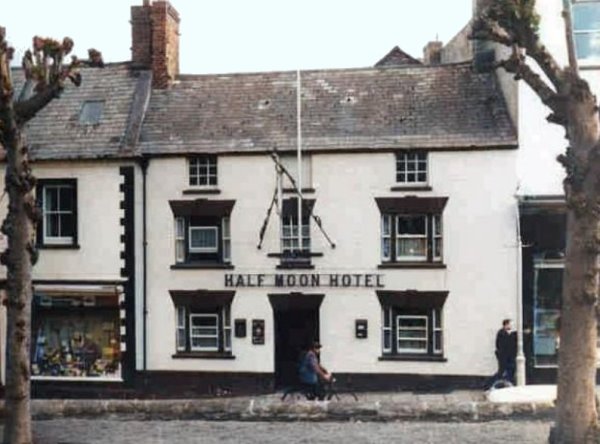
A colourised photograph of 1960 by Charrington & Co Ltd's surveyors as part of a 'stocktaking' exercise of photographing Brutton's pubs prior to the brewery takeover.
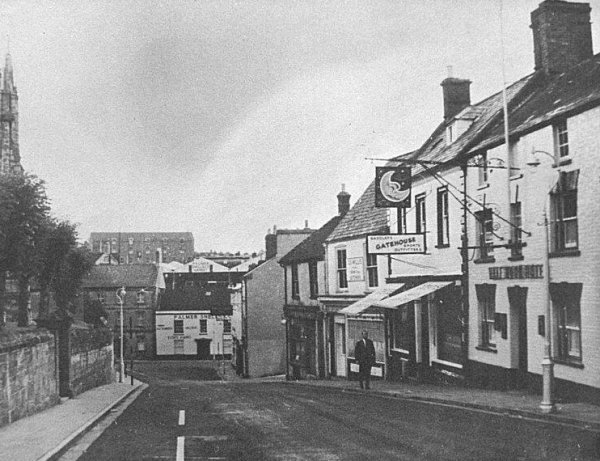
The Half Moon circa 1960. The steel frame supporting the sign is the same as the previous photograph but the sign itself has been renewed.
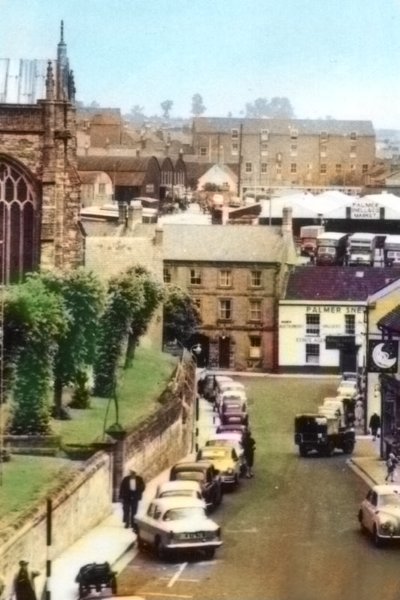
A colourised photograph showing the lower half of Silver Street. I'd guess the photograph dates to the late 1960s or early 1970s. The sign of the Half Moon is seen at the right edge of the photo.
owners / lessees / licensees
1760 – Nathaniel
Hayne (Poor Rate
Book) 2¾d.
1790 –
Mrs Betty Kitson
- conveyance
transferred from
William Latton
for £300
1798 – Robert
Tucker,
innholder,
conveyance
transferred from
Metty Kitson for
£315
1799 – Mrs
Kitson, owner -
John Mole,
occupier. Tax £1
9s 2d (Land Tax
Redemption)
1822 – William
Bengefield
(Pigot’s 1822
Directory)
listed as Half
Moon
1824 – William
Bengefield
(Pigot's 1824
Directory)
1827 – William
Bengefield (1827
Juror's List)
1828 – Jane R of
James Edwards
(Land Tax
Returns) Half
Moon Inn
1829 – James
Edwards,
owner/occupier
(Land Tax
Returns)
1830 – James
Edwards (Pigot’s
1830 Directory)
listed as Half
Moon
1830 – Thomas,
Benge (ie
Benjamin Thomas)
(Land Tax
Returns)
1839 – Benjamin
Thomas (Robson’s
1839 Directory)
listed as Half
Moon
1841 – Benjamin
Thomas – Inn
Keeper (1841
census) pub not
named
1842 – Benjamin
Thomas (Pigot’s
1842-4
Directory)
listed as Half
Moon
1850 – Benjamin
Thomas (Hunt &
Co's 1850
Directory)
1851 – Benjamin
Thomas –
Licensed
Victualler (1851
census) listed
as Half Moon Inn
1852 – Benjamin
Thomas – Inn
Keeper (Slater’s
1852 Directory)
– listed as Half
Moon
1861 – Henry
Trott (Kelly's
1861 Directory -
Inns & Hotels)
1861 – Henry
Trott – Inn
Keeper (1861
census) listed
as Half Moon Inn
1871 – John
Knight – Inn
Keeper (1871
census) pub name
not listed
1875 – John
Knight (Kelly's
1875 Directory -
Hotels & Inns)
1879 – H Marsh
(Whitby's 1879
Yeovil Almanack
Advertiser)
1880 – H Marsh
(Whitby's 1880
Yeovil Almanack
Advertiser)
1881 – Hugh
Marsh – Hotel
Keeper (1881
census) listed
as Half Moon
1881 – H Marsh
(Whitby's 1881
Yeovil Almanack
Advertiser)
1889 – Robert
Leach (Kelly’s
1889 Directory)
listed as Half
Moon
1891 – Robert
Leach – Hotel
Proprietor (1891
census) listed
as Half Moon
1895 – Robert
Leach (Kelly’s
1895 Directory)
listed as Half
Moon PH
1901 – Sarah
Leach (43 year
old widow of
Robert above) -
Licensed
Victualler (1901
census)
1902 – Sarah
Leach (Kelly’s
1902 Directory)
listed as Half
Moon
1911 – Sarah
Leach - Licensed
Victualler (1911
census)
1914 – Sarah
Leach (Kelly’s
1914 Directory)
listed as Half
Moon PH
1919 – Sarah
Leach (Kelly’s
1919 Directory)
listed as Half
Moon PH
1923 – Edward
Biggin (Kelly’s
1923 Directory)
listed as Half
Moon PH
1938 – EW Biggin
(1938 Yeovil
Directory)
listed as Half
Moon
1939 – Edward
Biggin (Kelly’s
1939 Directory)
listed as Half
Moon PH
1947 – EW Biggin
(1947 Yeovil
Directory)
listed as Half
Moon
1949 – Mrs A
Biggin (Kelly’s
1949 Directory)
listed as Half
Moon
1951 – Mrs A
Biggin (1951
Yeovil
Directory)
listed as Half
Moon
1957 – BP Biggin
(1957 Yeovil
Directory)
listed as Half
Moon
1960 – BP Biggin
(1960 Yeovil
Directory)
listed as Half
Moon. Known as
"Buff"
1960's – Johnny
Fisk, early
1960's (ref:
Mike Bolton)
1965 – Licensee
not named (1965
Yeovil
Directory)
listed as Half
Moon
1968 – Licensee
not named
(Kelly’s 1968
Directory)
listed as Half
Moon Inn
1969 – Licensee
not named
(Kelly’s 1969
Directory)
listed as Half
Moon Inn
1970 – Licensee
not named
(Kelly’s 1970
Directory)
listed as Half
Moon Inn
1971 – Licensee
not named
(Kelly’s 1971
Directory)
listed as Half
Moon Inn